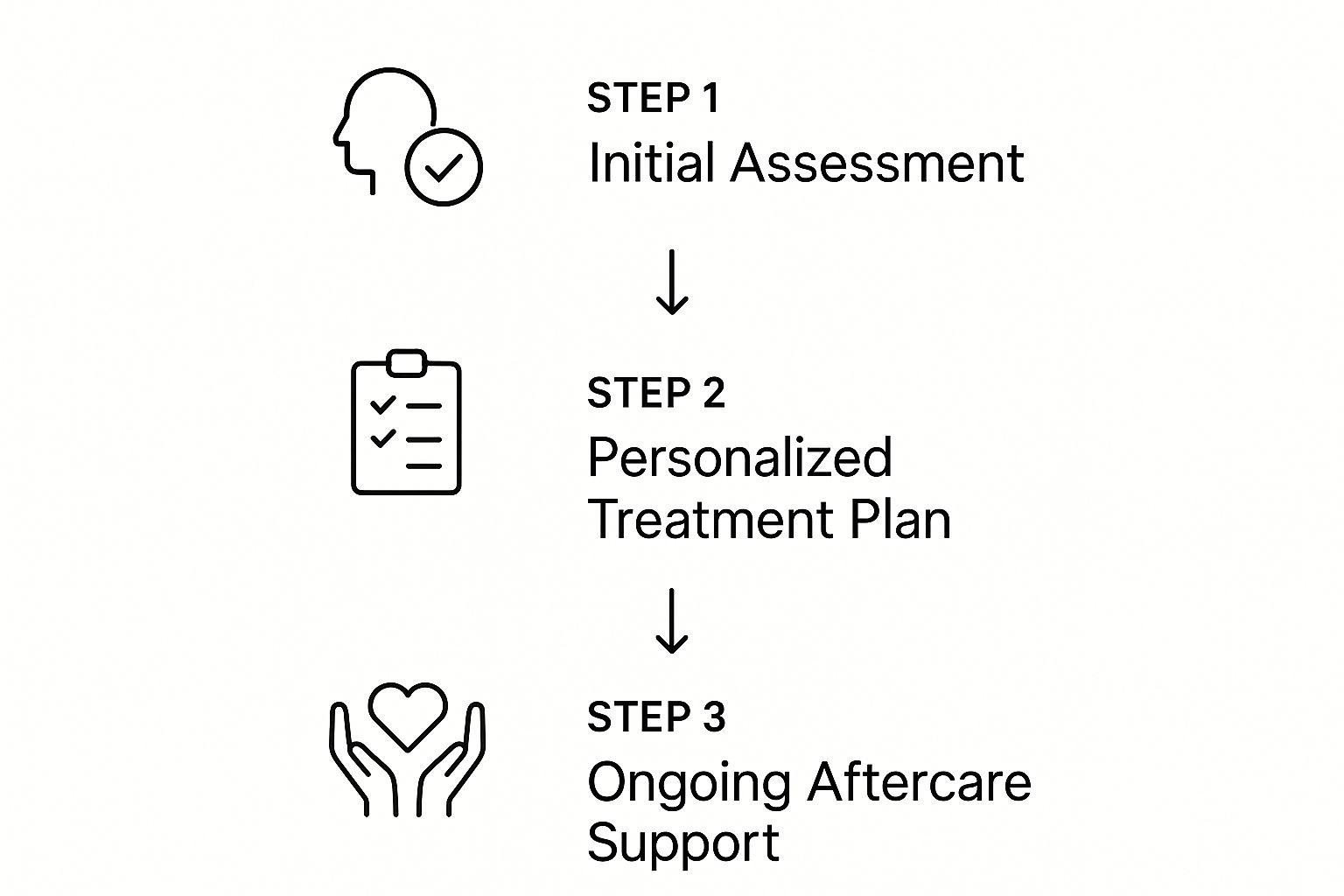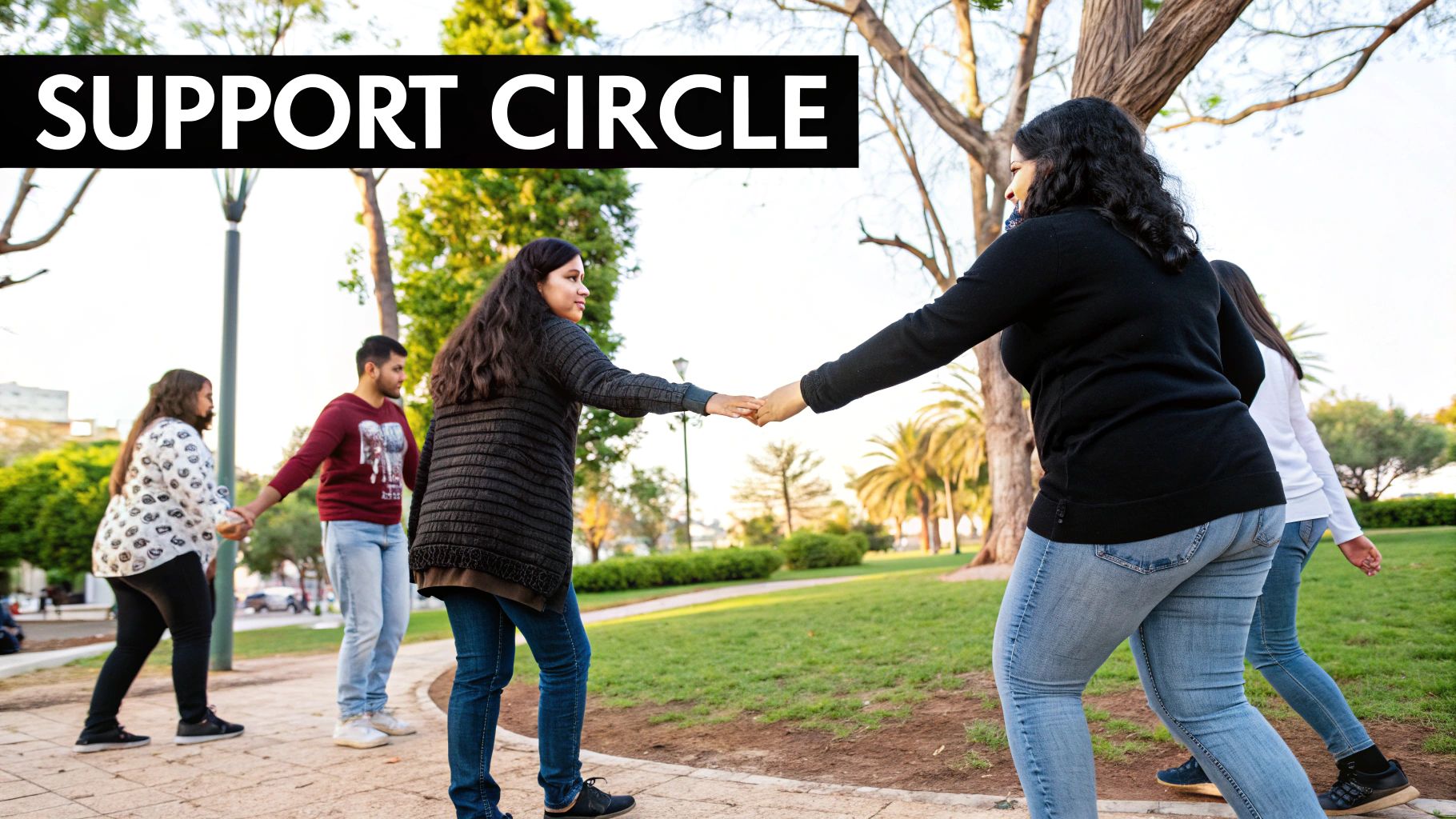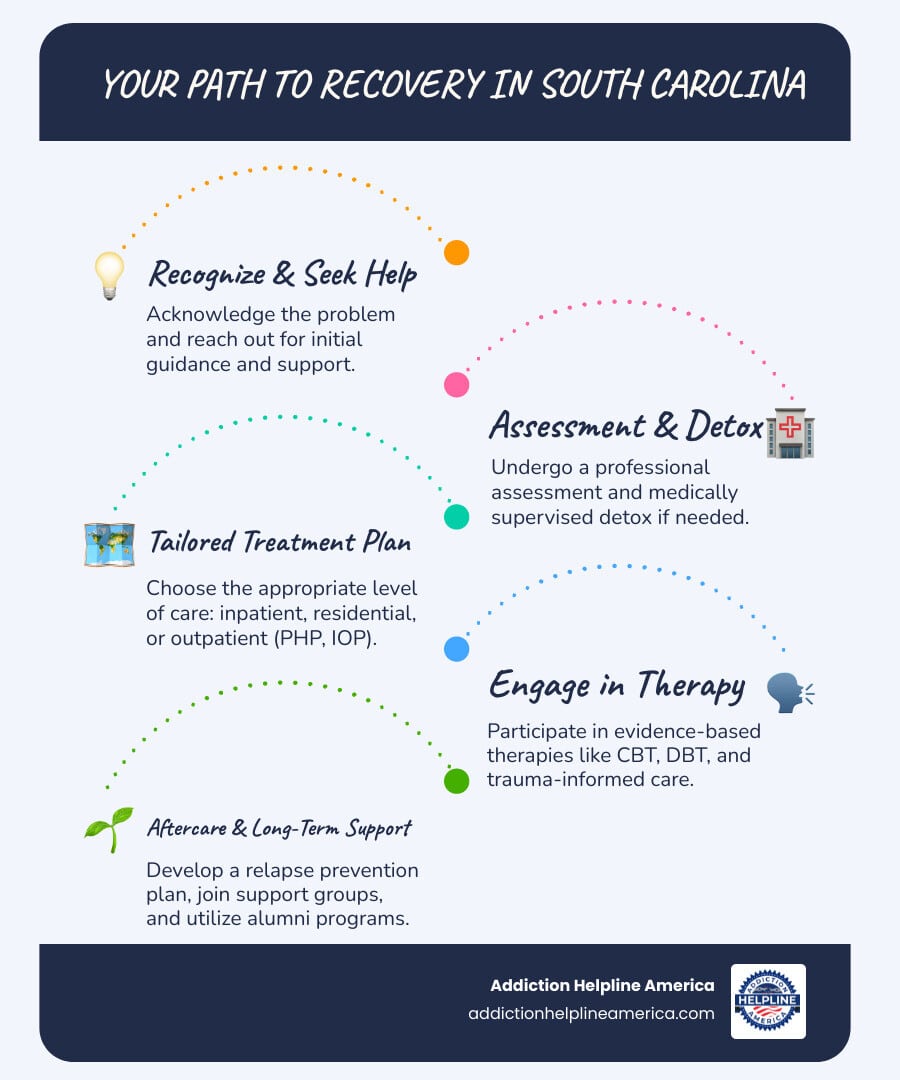
When people think of “Amy Winehouse rehab,” they often picture the tabloid headlines that followed her every move. Her struggle with addiction was as public and raw as her incredible voice, a painful cycle of recovery attempts played out for the entire world to see. It’s a story that starkly illustrates just how hard it is to fight substance abuse, especially when you’re living under a microscope.
Her Public Battle Behind the Music
Amy Winehouse had a talent that felt like it was from another time. She effortlessly blended classic soul and jazz into a sound that was uniquely hers, and it resonated with millions. Her album Back to Black made her a global superstar, but the fame came at a steep price. Suddenly, every part of her life was under intense scrutiny, and her personal struggles became front-page news. The line between her art, which was often born from her pain, and her real life completely disappeared.
This blurring of art and life meant her turmoil became part of her public brand. Even as she was winning Grammy awards for her music, her life away from the stage was a constant source of sensational headlines and invasive paparazzi photos. Her fight wasn’t just a private one; it became a public spectacle that, for better or worse, shaped how a generation viewed addiction and the long road to recovery.
The Cycle of Rehab and Relapse
The phrase “Amy Winehouse rehab” became a media fixture as she tried, again and again, to get well. Her journey was a winding, difficult path—one that many people battling addiction know all too well, but hers was magnified by the relentless glare of the media. This cycle really ramped up in late 2007 and early 2008 when her substance use grew so severe that her family and team knew they had to intervene.
“Her struggle really drives home a fundamental truth about recovery: it’s almost never a straight line. For Amy, any step forward seemed to be followed by a public stumble, showing just how powerful the grip of addiction is, especially when other mental health challenges are in the mix.”
Her history is marked by repeated, earnest attempts to find solid ground. After a particularly damaging video was leaked by tabloids in January 2008, she checked into a rehab program for two weeks. While her doctor later confirmed she had quit illegal drugs that year, her fight was far from won. She continued to battle a severe alcohol addiction for the remainder of her life, falling into the common and dangerous trap of replacing one substance with another.
Key Moments in Amy Winehouse’s Public Rehab Timeline
To truly understand the pressures she faced, it helps to look at the timeline of events as they unfolded publicly. The table below lays out some of the critical moments in her journey, showing the pattern of interventions, recoveries, and relapses that the world witnessed.
| Year | Event | Significance |
|---|---|---|
| 2007 | Cancels UK & US tours | Cited “health reasons,” this was one of the first major public signs that her substance use was impacting her career. |
| Jan 2008 | Enters a 2-week rehab program | This was her first publicly acknowledged rehab stay, prompted by a video showing her allegedly using drugs. |
| May 2009 | Relocates to St. Lucia | An attempt to escape the London scene and get clean, but she continued to struggle with alcohol. |
| May 2011 | Enters The Priory Clinic | A well-known treatment center in London. She checked in for help with alcohol addiction before a planned European tour. |
| June 2011 | Disastrous Belgrade performance | Appears intoxicated on stage, leading to the cancellation of her entire European tour. This was her final public performance. |
| July 2011 | Passes away from alcohol poisoning | A tragic end to her long battle, with a coroner ruling it “death by misadventure.” |
This timeline isn’t just a list of dates; it’s a heartbreaking map of a young woman trying to find her way out of addiction while dealing with unimaginable fame. Each event represents a moment of hope, a setback, and a cry for help that was often drowned out by the noise of the media.
This sets the stage for a deeper conversation. Now, we’ll move past the headlines to really unpack what was happening behind the scenes—the nature of her addiction, the types of treatment she sought, and the vital lessons her story can teach us about the need for truly comprehensive and compassionate support.
The Reality of Sobriety and Relapse

When people talk about Amy Winehouse and rehab, the story is often painted with a broad, tragic brush. But the truth of her experience was much more complicated. Her journey pulls back the curtain on a difficult reality of recovery: it’s almost never a straight line. Progress and setbacks often go hand-in-hand, and getting sober from one substance can sometimes just hide a deeper struggle with another.
This was exactly what happened with Amy. She showed incredible resolve in her fight against hard drugs, even managing long stretches of sobriety. But that victory concealed a growing dependence on alcohol. This is a common and incredibly dangerous pitfall in recovery called substance substitution. Think of it like plugging a huge leak in a dam, only to have all that built-up pressure find another weak spot to burst through.
Call Now – Your Journey to Recovery Begins Today!

Take the first step towards a healthier life! Call now to connect with our compassionate team and start your recovery journey today. Your path to healing awaits!
Our recovery specialists are available 24/7 to provide support, and all calls are confidential and free. Reach out anytime – we’re here to help!
From Drug Abstinence to Alcohol Dependence
This troubling pattern became the central struggle in the last years of her life. Her stepmother, Jane Winehouse, has shared that Amy had successfully stayed away from heroin and crack cocaine for a few years. These periods of sobriety from drugs often happened when she was immersed in her work, with the structure of writing and creating music keeping her grounded.
Sadly, it was during these very times that alcohol addiction took hold and became the dominant, and ultimately fatal, problem.
“The family believed she was making progress, but the return to heavy drinking proved to be a fatal misstep in her recovery.”
This observation from those closest to her really gets to the heart of addiction. The root behaviors and psychological dependencies don’t just disappear when you take one substance away. If you don’t address what’s driving the addiction in the first place, those patterns will simply find a new target. For Amy, that target was alcohol.
The Dangers of Incomplete Sobriety
Her tragic end teaches us a powerful lesson. Real recovery is about so much more than just quitting a specific drug. It demands a complete overhaul of your behaviors, your coping skills, and your approach to mental health. Amy’s story is a clear and painful example that sobriety can be fragile, especially when the engine of addiction is still running under the surface.
Her experience is a stark reminder of a few key truths about the recovery process:
- Substance Substitution is a Real Threat: Trading one addiction for another is a classic relapse trigger. Because it’s legal and socially acceptable, alcohol is often underestimated as a replacement addiction.
- Structure Provides Stability: For Amy, the routine of her career seemed to be an anchor. Her biggest struggles came when that structure was gone, which shows just how vital consistent, healthy routines are in recovery.
- Recovery is a Continuous Process: Sobriety isn’t a finish line you cross once. It’s an ongoing commitment that requires constant awareness, hard work, and strong support systems.
Understanding these dynamics is critical, whether you’re supporting a loved one or walking this path yourself. Building a solid foundation for lasting sobriety means you have to plan for these complex challenges. For more on this, you can learn about building a durable foundation for lasting sobriety in our guide on relapse prevention strategies.
The Roots of Trauma and Addiction

When we talk about the “Amy Winehouse rehab” story, it’s easy to just focus on the headlines and the public struggles. But to really understand what happened, we have to look beneath the surface. Addiction isn’t just about a physical craving; it’s almost always a symptom of something deeper, a way of coping with a storm that’s raging inside.
For Amy, that storm was a powerful mix of unresolved trauma, ongoing mental health issues, and the relentless pressure of global fame. For so many people, substance use starts as a form of self-medication. It’s like trying to slap a bandage on a gaping wound. It might cover it up for a little while, but the real damage underneath just keeps getting worse.
The Vicious Cycle of Co-Occurring Disorders
Amy’s life is a classic, though tragic, example of what experts call co-occurring disorders—when addiction and mental health conditions are happening at the same time. Think of conditions like depression, anxiety, or bipolar disorder as creating a constant state of internal pain. Substances can feel like a quick fix to quiet that pain, but they end up creating a devastating feedback loop.
- Emotional Pain: The distress from an underlying mental health issue feels unbearable.
- Self-Medication: Drugs or alcohol are used to numb those feelings and find a temporary escape.
- Worsening Symptoms: But substance use often makes the mental health issues worse, leading to even more intense emotional pain.
- Increased Dependence: This drives a person to use more of the substance just to cope, and the cycle spirals downward.
Trying to break this cycle is incredibly hard without treatment that tackles both problems head-on. If you only treat the addiction without healing the underlying trauma, it’s like bailing water out of a boat that still has a hole in it. You’re working hard, but you’re not fixing the real problem.
“The real tragedy of Amy’s story is that her struggles were often seen as separate problems—the drugs, the drinking, the chaotic behavior. But they were all just different threads of the same tangled rope, pulling her deeper into a crisis that needed one unified, compassionate solution.”
A Pattern Seen Too Often
Amy Winehouse’s battle came to a heartbreaking end in July 2011, when she died from accidental alcohol poisoning. Her blood alcohol level was reportedly more than five times the legal driving limit in the UK. While she had managed to stay away from illegal drugs since 2008 and was getting psychiatric help, her severe alcohol use disorder was a powerful demon she couldn’t overcome.
This final chapter is a crucial reminder of how dangerous alcohol addiction can be, and why resources like an alcohol addiction helpline are so vital for anyone facing a similar struggle.
Her story is part of a sad pattern, joining other musical icons like Jimi Hendrix and Janis Joplin who also died at the age of 27 while battling similar issues. It drives home the point that co-occurring disorders can’t be treated as separate battles. They must be fought on the same front, at the same time.
What Does Rehab Actually Look Like?
When most of us hear the word “rehab,” we might picture a remote celebrity retreat or a cold, clinical hospital. But what really happens when someone enters treatment? The story of Amy Winehouse’s rehab journey, with its ups and downs, highlights a critical truth: recovery isn’t just about stopping drug or alcohol use. It’s a structured, medical process designed to help a person rebuild their life from the inside out.
Imagine trying to build a new house where an old, crumbling one once stood. You can’t just start putting up fresh walls. First, you have to clear away all the rubble and make sure the foundation is solid. In recovery, this initial phase is detoxification (detox). It’s where the body, under close medical supervision, rids itself of substances. This can be the most physically intense part of the journey, and professional oversight is essential to manage withdrawal symptoms safely.
The Core Stages of Treatment
Once detox is complete, the real construction work can begin. This is where treatment becomes deeply personal, because no two people walk the same path to recovery. One of the first major decisions is choosing the right treatment setting.
- Inpatient (Residential) Rehab: This means living at a treatment center for a specific period, often 30 to 90 days. It creates an immersive, structured environment away from daily triggers, which is vital for anyone dealing with severe addiction or co-occurring mental health issues.
- Outpatient Rehab: This model offers more flexibility, allowing individuals to live at home and attend therapy sessions several times a week. It’s a good fit for people who have a strong support system at home and whose addiction is less severe.
The image below gives a bird’s-eye view of how a typical rehab program flows, from that first call for help all the way to long-term support.

As you can see, rehab isn’t a one-and-done event. It’s a continuum of care that adapts to a person’s changing needs over time.
To help you better understand the two main options, here’s a straightforward comparison.
Comparing Inpatient vs. Outpatient Rehab Programs
| Feature | Inpatient Rehab (Residential) | Outpatient Rehab |
|---|---|---|
| Living Situation | Reside at the facility 24/7 | Live at home, travel to facility for sessions |
| Intensity | High-intensity, highly structured daily schedule | Lower intensity, scheduled sessions a few times per week |
| Environment | Immersive, free from outside triggers and distractions | Continue with daily life, work, and family commitments |
| Best For | Severe addictions, co-occurring disorders, or weak support systems | Milder addictions, strong home support, and work/family obligations |
| Typical Duration | 30, 60, or 90+ days | Varies widely, can last for months or longer |
Choosing the right program is a crucial first step, as the environment plays a huge role in a person’s ability to focus on healing.
Building a Foundation for Sobriety That Lasts
At the very heart of any effective rehab program is therapy. This is where the heavy lifting happens—where individuals dig deep to understand the roots of their addiction and start building a new toolkit of coping skills. Therapies like Cognitive Behavioral Therapy (CBT) are fundamental, teaching people how to spot and reframe the destructive thought patterns that fuel substance use.
“True recovery isn’t just about saying “no” to a drink or a drug. It’s about building a life where you no longer feel the need to use it to cope. That means healing old wounds, managing mental health, and learning how to navigate stress in a healthy way.”
Finally, no rehab plan is complete without solid aftercare planning. Think of this as the ongoing maintenance plan for the new life you’ve built. It can include continued therapy, joining support groups like Alcoholics Anonymous (AA), and nurturing a strong network of sober friends. Amy Winehouse’s story is a tragic reminder that without this kind of robust, long-term support, even hard-won periods of sobriety can remain fragile.
To get a more detailed look at this entire process, you can explore our in-depth guide that breaks down what to expect in rehab from start to finish.
Lessons Learned From Amy Winehouse’s Story

It’s easy to look back at Amy Winehouse’s story and see only tragedy. But her public struggle with addiction left behind some powerful, hard-won lessons for all of us. When we reflect on her life, we can find critical insights that help us better support ourselves and those we care about, turning her pain into a guide for compassion and real action.
One of the most profound takeaways is the importance of early intervention. Amy’s battles with bulimia and her mental health began long before substance use became a front-page crisis. Too often, we see addiction as the problem, when it’s really just the final, most visible symptom of deeper, untreated issues. It’s like trying to fix a rotted tree trunk without ever tending to the diseased roots.
The Need for a Health-First Approach
Amy’s story screams for the need for integrated treatment. She wasn’t just dealing with one thing; she was grappling with a tangled web of addiction, mental health issues, and unimaginable public pressure. Trying to treat each of these in isolation is like trying to put out a fire one spark at a time. A truly effective approach has to look at the whole person, combining mental healthcare and addiction treatment under one cohesive plan.
“We have to shift our perspective. The narrative around Amy Winehouse’s rehab often focused on her behavior, but the real story was a health crisis. Addiction is a disease, not a moral failing. It demands medical and psychological support, not judgment.”
This health-first viewpoint is everything. It chips away at the stigma that keeps so many people from ever asking for help in the first place.
Core Truths from Her Experience
Her journey also hammers home some difficult but essential truths about what recovery really looks like:
- Recovery is not a straight line. Relapse and setbacks are a common, almost expected, part of the process. They aren’t failures; they’re signals that the current treatment plan needs to be adjusted.
- Substance substitution is a real danger. We saw this with Amy. Overcoming one addiction only to be consumed by another—in her case, alcoholism—is a huge risk. Real recovery means getting to the heart of what drives the addictive behavior itself.
- A support network must be strong, not enabling. Love is vital, but it has to be paired with firm boundaries. Support should point toward professional help, not create a cushion that enables destructive habits to continue.
Understanding these complexities is the first step toward creating better outcomes for others. For anyone looking to explore this topic further, there are many compelling research topics on substance abuse that dive into these very issues. Amy’s story is a heartbreaking but powerful reminder that knowledge and compassion can, and do, save lives.
Call Now – Your Journey to Recovery Begins Today!

Take the first step towards a healthier life! Call now to connect with our compassionate team and start your recovery journey today. Your path to healing awaits!
Our recovery specialists are available 24/7 to provide support, and all calls are confidential and free. Reach out anytime – we’re here to help!
How to Find Help for Addiction Today
Amy Winehouse’s story is a heartbreaking look at how isolating addiction can feel, but it’s also a powerful reminder for all of us. Realizing that you or someone you care about needs help is the single most important—and bravest—step you can take. You are not alone on this journey. Professional, confidential support is available right now, waiting for your call.
The path to recovery often starts with simply admitting there’s a problem. The signs might be subtle at first, like shifts in mood or personality, or they could be more obvious, like missed work and declining health. Think of them as warning lights on your car’s dashboard—ignoring them only leads to a more serious breakdown down the road.
“Taking that first step can feel overwhelming, but it’s a sign of immense strength, not weakness. Reaching out is the moment you start taking back control from addiction.”
Once you see the signs, the next move is to connect with people who know how to help. This is where professional guidance can make all the difference.
Starting the Conversation
Bringing up addiction with a loved one is one of the toughest conversations you’ll ever have. You have to approach it with compassion, patience, and zero judgment. It’s best to frame the talk around your concern for their well-being, not their actions. Using “I” statements like, “I’ve been worried about you lately,” feels much less like an attack than saying, “You are making bad choices.”
If you’re looking for more guidance on navigating this critical dialogue, our article on how to help someone with addiction offers practical advice to get you started.
Finding Professional Support
The good news is, you don’t have to figure this out by yourself. There are dedicated services and trained professionals ready to connect you with the right kind of care.
- National Helplines: Think of these as your immediate, confidential lifeline. Specialists are available 24/7 to listen without judgment and provide information on treatment options that fit your situation.
- Mental Health Services: Addiction rarely travels alone; it’s often intertwined with depression, anxiety, or trauma. Integrated care that addresses both mental health and substance use is key to long-term success.
- Rehab Facilities: These centers provide a structured path forward, whether it’s through flexible outpatient programs or more intensive inpatient care for detox and therapy.
The journey through Amy Winehouse’s rehab story shows the devastating cost of waiting too long. Today, getting help is more straightforward than ever before. Making that confidential call is a simple action that can genuinely change a life.
Call Now – Your Journey to Recovery Begins Today!

Take the first step towards a healthier life! Call now to connect with our compassionate team and start your recovery journey today. Your path to healing awaits!
Our recovery specialists are available 24/7 to provide support, and all calls are confidential and free. Reach out anytime – we’re here to help!
A Few Common Questions
After looking closely at Amy Winehouse’s life, you might still have some questions. Her struggle with addiction was complicated and often twisted by the stories told in the media. Let’s clear up some of the most common points about the Amy Winehouse rehab story and her personal battles.
Did Amy Winehouse Ever Get Sober?
Yes and no. It’s a complicated answer, but it’s an important one. Amy did manage to stop using hard drugs like heroin for the last few years of her life, which is a massive accomplishment that she largely achieved on her own. The problem was, she fell into a common trap known as substance substitution. She swapped her drug addiction for a dangerous and ultimately fatal dependence on alcohol.
Her experience really drives home the point that recovery isn’t just about quitting one substance. It’s about getting to the root of why the addiction is there in the first place and healing from the inside out.
What Part Did Mental Health Play in Her Addiction?
Mental health was at the very core of Amy’s struggles. She reportedly battled depression and showed many signs of what experts believe was an undiagnosed bipolar disorder. For so many people, substance use starts as a desperate attempt to self-medicate the emotional pain that comes with mental health conditions.
“When someone is dealing with both addiction and a mental health issue at the same time what we call co-occurring disorders they need treatment that addresses both. If you only treat the addiction, the underlying mental health issue can easily pull them back into substance use. Amy’s story is a tragic but powerful example of why this dual-focus approach is so critical.”
What Can We Learn From How the Public Reacted to Her?
Amy’s story is a tough lesson in how damaging intense media attention and public judgment can be for someone trying to recover. The constant hounding from paparazzi and sensational headlines often turned her health crisis into a form of entertainment. This kind of public pressure can create overwhelming feelings of shame and isolation, making it even harder for someone to ask for help or stay on the path to recovery.
Her experience really highlights why we need to change the conversation around addiction. It needs to be treated with compassion, as the serious illness it is, not as a moral weakness or a public spectacle.
If you or someone you care about is fighting a similar battle, please know that you are not alone. Confidential, professional help is just a phone call away. Addiction Helpline America offers a free, 24/7 lifeline to connect you with the resources and support you need to begin your own journey to recovery. You can take that first, brave step by visiting our website at Addiction Helpline America.
Our helpline is 100%
free & confidential
If you or someone you care about is struggling with drug or alcohol addiction, we can help you explore your recovery options. Don’t face this challenge alone—seek support from us.
Programs
Resources
Will my insurance
cover addiction
treatment?
We're ready to help
Find the best
drug or alcohol treatment
center
Are you or a loved one struggling with addiction? Call today to speak to a treatment expert.
















